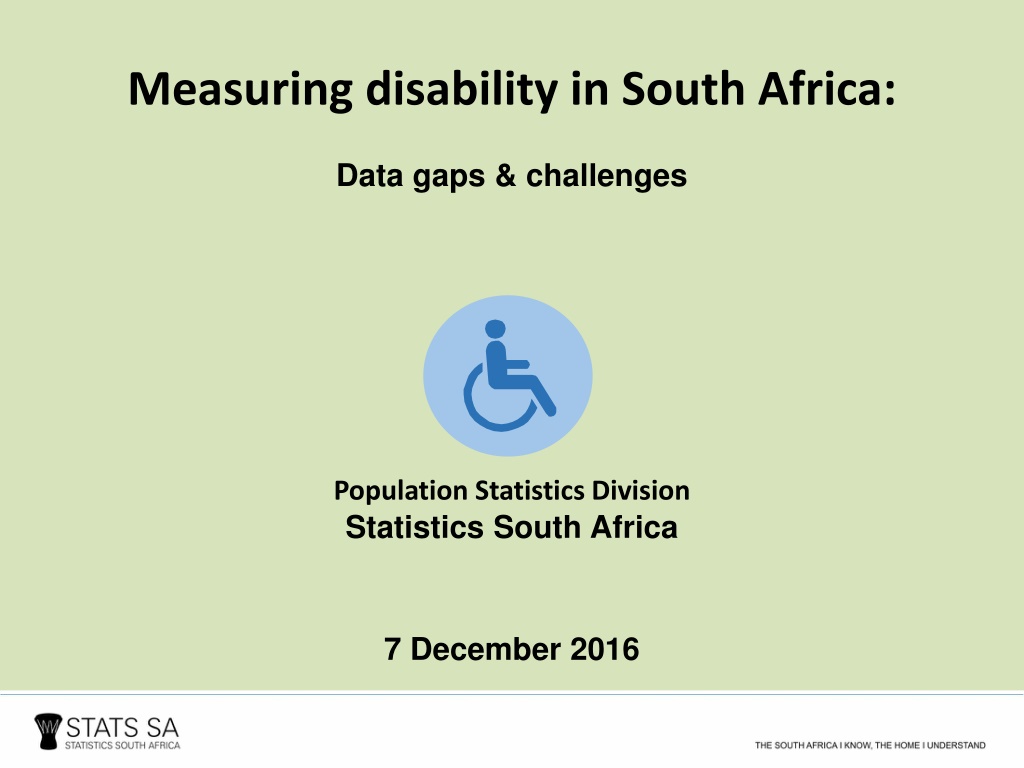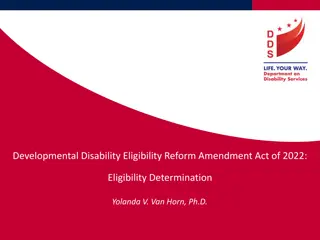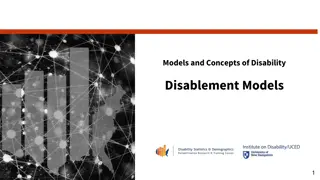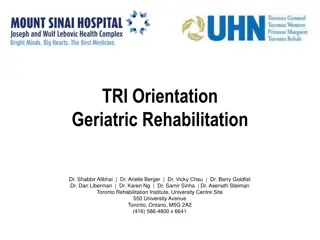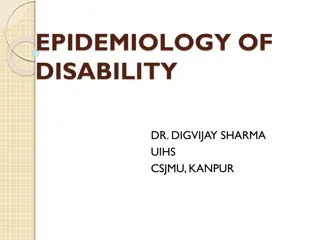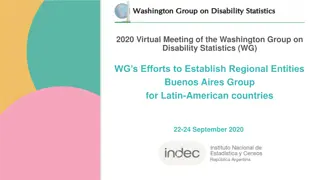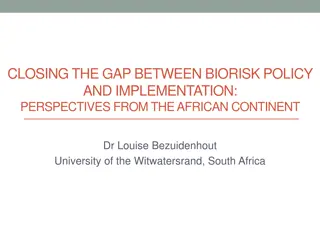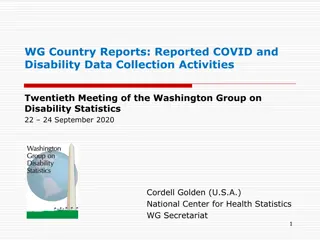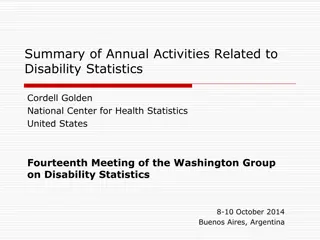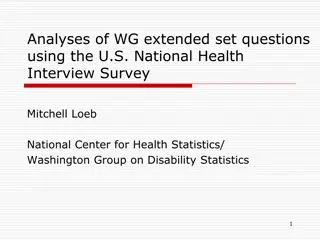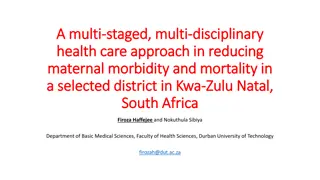Measuring disability in South Africa:
Data challenges and gaps in measuring disability in South Africa hinder planning and resource allocation for persons with disabilities. Clear definitions, harmonization of concepts, and improved data sources are essential for accurate measurement. The use of Washington Group questions in surveys plays a crucial role in assessing disability across various domains such as seeing, hearing, walking, remembering, and self-care.
Download Presentation

Please find below an Image/Link to download the presentation.
The content on the website is provided AS IS for your information and personal use only. It may not be sold, licensed, or shared on other websites without obtaining consent from the author. Download presentation by click this link. If you encounter any issues during the download, it is possible that the publisher has removed the file from their server.
E N D
Presentation Transcript
Measuring disability in South Africa: Data gaps & challenges Population Statistics Division Statistics South Africa 7 December 2016
Presentation outline Background Defining & measuring disability Data sources in South Africa Indicators Questions & comments
Background Disability measurement content, methodologies and indicators need to be clearly defined, data sources identified and clear targets set Inadequate disability statistics continue to hinder efforts made at all levels of planning in allocating resources aimed at improving the lives of persons with disabilities Output data on disability statistics need some further validation prior to input into health metrics models such as the Sullivan Method of measuring health life expectancy
Defining & measuring disability Harmonization of definitions and concepts across sectors critical Use of WG questions in Censuses and surveys provide improved approach of measuring disability Focus on the level of difficulty experienced in the six domains Seeing, communicating, hearing, walking, remembering and concentrating, and self-care.
Data sources on disability indicators Data source Frequency Type of questions on disability General Household Survey Large Sample Community Survey Censuses Annual Washington Group (WG) Assistive device usage 10-year cycle Decennial (ten years) Proposed to be annual Administrative data from collective living quarters
Questions in Census 1996 & 2001 Census 1996: If Yes, Circle all applicable disabilities 1 = Sight (serious eye defects) 2 = Hearing/speech 3 = Physical disability (paralysis) 4 = Mental disability Does (the person) have a serious sight, hearing, physical or mental disability? 1 = Yes 2 = No Census 2001: 0 = None 1 = Sight (blind/sever visual limitations) 2 = Hearing (deaf, hard of hearing) 3 = Communication (speech impairment) 4 = Physical (e.g. Need a wheelchair, crutches) 5 = Intellectual (various learning difficulties) 6 = Emotional (behavioral, psychological) Does (the person) have any serious disability that prevents his/her full [participation in life activities) such as education, work, social life?) Mark any that apply.
Coverage Censuses Census covers all household in SA - data available at very low levels of disaggregation Exclusions : institutions, transients, homeless, children below the age of five Surveys Disability a rare event affected by sample size Makes analysis using more than 2 dimensions (such as age, sex, race, province) rather unreliable
Within universe for calculation of disability index Rememberin g /Concentrati ng Walking or climbing stairs Communicatin g Seeing Hearing Self Care 39 064 78742 257 767 43 014 898 42 318 455 41 866 559 41 204 257 No difficulty 4 085 898 1 251 907 473 450 1 100 135 1 405 098 837 363 Some difficulty A lot of difficulty Cannot do at all 660 874 229 918 115 699 317 216 365 015 266 765 77 205 58 451 75 583 105 964 91 163 322 104 43 888 76443 798 043 43 679 630 43 841 770 43 727 835 42 630 489 Total Out of calculation 23 372 20 791 21 864 16 340 35 694 63 164 Do not know Cannot yet be determined Unspecified/mi ssing 52 47 12 248 5 799 29 259 926 246 1 381 118 1 474 426 1 579 564 1 429 399 1 500 518 1 673 408 1 404 542 1 495 264 1 613 676 1 451 538 1 565 471 2 662 818 Total
The disability index used in this report is based on multiple basic action difficulties in seeing, hearing, communicating, walking, remembering/concentrating, and self-care EXCLUSIONS FROM ANALYSIS Population that was enumerated in institutions such as prisons and hospitals (750 060) Transients and the homeless (59 057) Data for children below the age of five excluded due to reporting errors (5 668 137 ) The disability index is calculated based on population that responded on the various disability types Unspecified/missing cases, do not know and cannot yet be determined were excluded
Gaps and limitations Misreporting and bias No data on child disabilities (ages 0-4 years) Frailty in old age exaggerating disability at ages 60+ Under reporting due to cultural beliefs Subjectivity of the WG questions. Responses based on self- assessment rather than scientific methods of testing for presence or absence of the condition
Gaps and limitations Coverage & high non-response Sample Size for annual General Household Survey about 30 000 households - limited to disaggregation of data at provincial level & hence no small area statistics Census 2011 (disability questions only asked of hh based population) Some disability types not measured at all Not all assistive devices are covered
Initiatives in narrowing data gaps The Washington group together with UNICEF have collaborated to produce a more effective module in measurement of disabilities among children (2-17 years old) Stats SA together with DSD and UNDP conducted a research study to test childhood disability module in South Africa
Census 2011 and CS 2016 compared: Six domains 0.3 0.0 0.0 0.1 0.0 0.1 0.0 0.2 0.0 0.3 0.0 0.1 0.0 0.1 0.1 0.1 0.2 0.1 0.2 0.1 0.1 0.3 0.2 0.3 0.2 0.5 0.6 0.8 0.6 0.9 0.7 0.8 1.5 1.7 1.1 1.5 1.3 0.6 1.9 2.9 2.5 3.1 2.0 3.3 3.2 3.6 8.5 9.3 98.4 98.2 97.2 96.5 96.5 96.4 96.2 95.7 95.6 94.6 89.7 89.0 CENSUS 2011 CS 2016 CENSUS 2011 CS 2016 CENSUS 2011 CS 2016 CENSUS 2011 CS 2016 CENSUS 2011 CS 2016 CENSUS 2011 CS 2016 SEEING HEARING COMMUNICATING WALKING/ CLIMBING STAIRS REMEMBERING / CONCENTRATING SELF CARE No difficulty Some difficulty A lot of difficulty Cannot do at all Do not know
INDICATORS Disability prevalence by province: Census 2011 and Community Survey 2016 12.0 10.0 8.0 % 6.0 4.0 2.0 0.0 Western Cape Eastern Cape Northern Cape Kwazulu- Natal Mpumalang a Free State North West Gauteng Limpopo South Africa Census 2011 5.4 9.6 11.0 11.1 8.4 10.0 5.3 7.0 6.9 7.5 CS 2016 6.3 8.6 10.7 11.0 8.6 8.8 6.7 7.6 6.4 7.7
INDICATORS Disability prevalence by age: Census 2011 and Community Survey 2016 93.5 93.5 91.5 91.1 8.9 8.5 6.5 6.5 WITH DISABILITIES WITHOUT DISABILITIES WITH DISABILITIES WITHOUT DISABILITIES CENSUS 2011 COMMUNITY SURVEY 2011 Male Female
INDICATORS Disability prevalence by age: Census 2011 versus Community Survey 2016 80 70 60 50 % 40 30 20 10 0 5-9 10-14 15-19 20-24 25-29 30-34 35-39 40-44 45-49 50-54 55-59 60-64 65-69 70-74 75-79 80-84 85+ Total Census 2011 10.8 4.1 2.6 2.4 2.5 3 3.8 5.5 8.7 12.2 15.6 18.7 22.7 29.4 36.6 44.5 53.2 7.5 CS 2016 4.2 3.0 2.6 2.4 2.7 3.4 3.9 5.7 9.0 13.7 18.3 24.2 31.5 40.9 49.9 61.1 73.1 7.7
Disability prevalence by population group: Census 2011 and Community Survey 2016 10.0 9.0 8.0 7.0 6.0 5.0 % 4.0 3.0 2.0 1.0 0.0 Black African Coloured Indian White Other Total Census 2011 7.8 6.2 6.2 6.5 5.6 7.5 CS 2016 7.6 7.5 8.4 9.2 7.7
Assistive devices 0.1 0.1 0.1 0.1 0.4 0.4 0.4 0.5 86.9 90.8 96.6 96.9 97.5 98.5 99.4 99.6 12.7 9.2 3.0 2.7 2.1 1.4 0.6 0.4 CENSUS 2011 CS 2016 CENSUS 2011 CS 2016 CENSUS 2011 CS 2016 CENSUS 2011 CS 2016 EYE GLASSES HEARING AID WALKING STICK OR FRAME A WHEELCHAIR Yes No do not know
Education and income: Census 2011 Primary education 10000 8000 Income per month in Rands 6000 4000 2000 0 10 20 30 40 50 60 70 80 90 Age Persons with no difficulty Persons with some difficulty in at least two health and functioning areas
Education and income Secondary education 18000 16000 14000 Median income per month in Rands 12000 10000 8000 6000 4000 2000 0 20 30 40 50 60 70 80 90 Age Persons with no difficulty Persons with some difficulty in at least two health and functioning areas
Use of Census 2011 disability input data into health metrics models (Sullivan Method) Male Female Disability Free Life Expectancy Disability Free Life Expectancy Age 50 51 52 53 54 55 56 57 58 59 60 61 62 63 64 65 66 67 68 69 70 71 72 73 74 75 Life Expectancy Life Expectancy 21.3 20.7 20.1 19.6 19.1 18.5 18.0 17.5 16.9 16.4 15.9 15.4 14.9 14.5 14.0 13.5 13.1 12.6 12.2 11.8 11.4 11.1 10.6 10.3 9.9 9.6 17.0 16.5 15.9 15.4 14.8 14.3 13.8 13.3 12.8 12.3 11.8 11.3 10.9 10.4 10.0 9.5 9.1 8.7 8.3 7.9 7.5 7.2 6.8 6.5 6.2 5.9 26.5 25.8 25.1 24.4 23.7 23.1 22.4 21.7 21.1 20.4 19.7 19.1 18.5 17.9 17.3 16.6 16.0 15.4 14.9 14.3 13.7 13.3 12.7 12.2 11.7 11.3 19.4 18.8 18.1 17.5 16.9 16.3 15.7 15.1 14.5 13.9 13.3 12.7 12.2 11.6 11.1 10.5 10.0 9.5 9.0 8.5 8.0 7.6 7.2 6.8 6.4 6.0
Recommendations on addressing data gaps challenges Stats SA together with relevant stakeholders will continue advocating for a specialised survey to measure disability given the challenges on data gaps Use administrative sources of data to collect and report information on disability very critical
